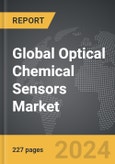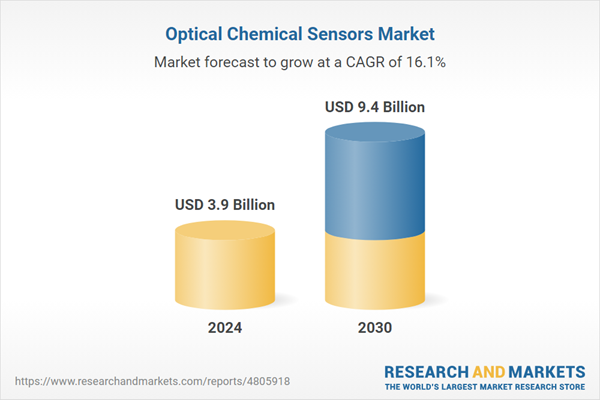Global Optical Chemical Sensors Market - Key Trends & Drivers Summarized
How Are Optical Chemical Sensors Revolutionizing Detection and Monitoring?
Optical chemical sensors are playing an increasingly critical role in the detection and monitoring of chemical substances in various industries. These sensors work by detecting changes in the optical properties, such as absorbance, fluorescence, or phosphorescence, of a chemical compound when it interacts with a target analyte. Optical chemical sensors are widely used in environmental monitoring, healthcare, industrial process control, and food safety, offering a non-invasive, highly sensitive, and selective method of chemical detection. In healthcare, they are essential for monitoring physiological parameters, such as blood oxygen levels and glucose concentrations, while in environmental applications, they help in detecting pollutants and hazardous chemicals in air and water. The growing need for real-time, continuous monitoring in various sectors has made optical chemical sensors indispensable, driving demand across industries.What Trends Are Shaping the Optical Chemical Sensors Market?
Several key trends are driving the optical chemical sensors market, particularly the increasing demand for real-time, non-invasive monitoring systems in healthcare and environmental applications. The rise of wearable medical devices is a significant trend, with optical chemical sensors being integrated into smartwatches, fitness trackers, and other wearable health devices for continuous monitoring of vital signs such as blood oxygen levels. Another trend is the growing focus on environmental sustainability, driving demand for sensors that can detect pollutants and toxic chemicals in air, water, and soil. In industrial settings, optical chemical sensors are increasingly used for process optimization and safety monitoring, where precise chemical detection is crucial. Miniaturization of sensor technology is another important trend, allowing for the development of smaller, more portable sensors that can be deployed in a wider range of applications, from personal health monitoring to large-scale environmental monitoring systems.How Is Technology Advancing the Optical Chemical Sensors Market?
Technological advancements are propelling the optical chemical sensors market forward, making these sensors more accurate, reliable, and versatile. Innovations in materials science, such as the development of advanced nanomaterials and biocompatible polymers, have improved the sensitivity and selectivity of optical chemical sensors. These materials enable the detection of lower concentrations of analytes, making the sensors more effective in detecting trace amounts of pollutants or biomarkers in medical diagnostics. Advances in fiber optic technology are also enhancing the performance of optical chemical sensors, allowing for faster and more accurate signal transmission over long distances, which is especially valuable in environmental monitoring and industrial applications. Furthermore, the integration of optical chemical sensors with wireless communication technologies and IoT platforms is enabling real-time, remote monitoring of chemical parameters, expanding the potential applications in industries such as smart agriculture, oil and gas, and healthcare.What Is Driving the Growth in the Optical Chemical Sensors Market?
The growth in the optical chemical sensors market is driven by several key factors. The increasing demand for non-invasive, real-time monitoring in healthcare, particularly for wearable devices that track vital signs and physiological parameters, is a significant growth driver. The growing need for environmental monitoring, fueled by rising concerns over pollution and climate change, is also contributing to the demand for optical chemical sensors that can detect hazardous chemicals in air, water, and soil. In industrial settings, the adoption of optical chemical sensors for process optimization, safety, and quality control is expanding, as these sensors offer precise and reliable detection of chemical substances in real time. Additionally, advancements in sensor miniaturization and wireless communication technologies are making optical chemical sensors more portable and easier to integrate into various applications, further driving market growth.Report Scope
The report analyzes the Optical Chemical Sensors market, presented in terms of units. The analysis covers the key segments and geographic regions outlined below.Segments: Type (Fiber Optic Sensors, Infrared Sensors, Photoionization Sensors, Other Types); End-Use (Industrial, Environmental Monitoring, Medical, Defense & Homeland Security, Other End-Uses).
Geographic Regions/Countries: World; United States; Canada; Japan; China; Europe (France; Germany; Italy; United Kingdom; Spain; Russia; and Rest of Europe); Asia-Pacific (Australia; India; South Korea; and Rest of Asia-Pacific); Latin America (Argentina; Brazil; Mexico; and Rest of Latin America); Middle East (Iran; Israel; Saudi Arabia; United Arab Emirates; and Rest of Middle East); and Africa.
Key Insights:
- Market Growth: Understand the significant growth trajectory of the Fiber Optic Sensors segment, which is expected to reach US$4.4 Billion by 2030 with a CAGR of a 17.1%. The Infrared Sensors segment is also set to grow at 15.2% CAGR over the analysis period.
- Regional Analysis: Gain insights into the U.S. market, valued at $1.0 Billion in 2024, and China, forecasted to grow at an impressive 21.2% CAGR to reach $2.3 Billion by 2030. Discover growth trends in other key regions, including Japan, Canada, Germany, and the Asia-Pacific.
Why You Should Buy This Report:
- Detailed Market Analysis: Access a thorough analysis of the Global Optical Chemical Sensors Market, covering all major geographic regions and market segments.
- Competitive Insights: Get an overview of the competitive landscape, including the market presence of major players across different geographies.
- Future Trends and Drivers: Understand the key trends and drivers shaping the future of the Global Optical Chemical Sensors Market.
- Actionable Insights: Benefit from actionable insights that can help you identify new revenue opportunities and make strategic business decisions.
Key Questions Answered:
- How is the Global Optical Chemical Sensors Market expected to evolve by 2030?
- What are the main drivers and restraints affecting the market?
- Which market segments will grow the most over the forecast period?
- How will market shares for different regions and segments change by 2030?
- Who are the leading players in the market, and what are their prospects?
Report Features:
- Comprehensive Market Data: Independent analysis of annual sales and market forecasts in US$ Million from 2024 to 2030.
- In-Depth Regional Analysis: Detailed insights into key markets, including the U.S., China, Japan, Canada, Europe, Asia-Pacific, Latin America, Middle East, and Africa.
- Company Profiles: Coverage of players such as ABB Ltd., Alpha MOS France, Emerson Electric Company, General Electric Company, Halma PLC and more.
- Complimentary Updates: Receive free report updates for one year to keep you informed of the latest market developments.
Some of the 49 companies featured in this Optical Chemical Sensors market report include:
- ABB Ltd.
- Alpha MOS France
- Emerson Electric Company
- General Electric Company
- Halma PLC
- Honeywell International, Inc.
- Siemens AG
- Teledyne Technologies Inc.
Tariff Impact Analysis: Key Insights for 2025
Global tariff negotiations across 180+ countries are reshaping supply chains, costs, and competitiveness. This report reflects the latest developments as of April 2025 and incorporates forward-looking insights into the market outlook.The analysts continuously track trade developments worldwide, drawing insights from leading global economists and over 200 industry and policy institutions, including think tanks, trade organizations, and national economic advisory bodies. This intelligence is integrated into forecasting models to provide timely, data-driven analysis of emerging risks and opportunities.
What’s Included in This Edition:
- Tariff-adjusted market forecasts by region and segment
- Analysis of cost and supply chain implications by sourcing and trade exposure
- Strategic insights into geographic shifts
Buyers receive a free July 2025 update with:
- Finalized tariff impacts and new trade agreement effects
- Updated projections reflecting global sourcing and cost shifts
- Expanded country-specific coverage across the industry
Table of Contents
Companies Mentioned (Partial List)
A selection of companies mentioned in this report includes, but is not limited to:
- ABB Ltd.
- Alpha MOS France
- Emerson Electric Company
- General Electric Company
- Halma PLC
- Honeywell International, Inc.
- Siemens AG
- Teledyne Technologies Inc.
Table Information
| Report Attribute | Details |
|---|---|
| No. of Pages | 227 |
| Published | April 2025 |
| Forecast Period | 2024 - 2030 |
| Estimated Market Value ( USD | $ 3.9 Billion |
| Forecasted Market Value ( USD | $ 9.4 Billion |
| Compound Annual Growth Rate | 16.1% |
| Regions Covered | Global |









